| 20th Light Dragoons | |
|---|---|
| Active | 1792–1818 |
| Country | |
| Branch | |
| Type | Cavalry |
| Role | Line Cavalry |
| Size | One Regiment |
The 20th Regiment of Light Dragoons was a cavalry regiment of the British Army.
| 20th Light Dragoons | |
|---|---|
| Active | 1792–1818 |
| Country | |
| Branch | |
| Type | Cavalry |
| Role | Line Cavalry |
| Size | One Regiment |
The 20th Regiment of Light Dragoons was a cavalry regiment of the British Army.
The regiment was raised as the 20th (Jamaica) Regiment of (Light) Dragoons in 1792; [1] it was deployed to Jamaica in 1795 during the Second Maroon War. [2] The regiment saw action at the Battle of Blaauwberg in January 1806 during the second invasion of the Cape Colony, [3] and later at the Battle of Montevideo in February 1807 during the British invasions of the River Plate. [4] The 3rd Squadron was the sole cavalry detachment present in the Alexandria expedition later that year. [5] It also fought at the Battle of Rolica and at the Battle of Vimeiro in August 1808 during the Peninsular War. [1] In 1805 its title was simplified again to the 20th Regiment of (Light) Dragoons; it was disbanded in 1818. [1]
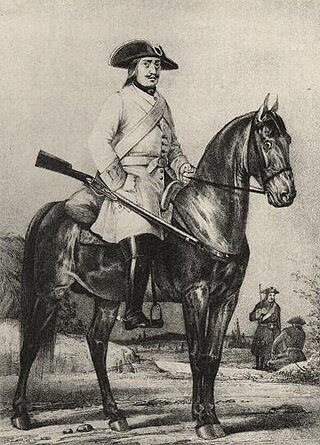
Dragoons were originally a class of mounted infantry, who used horses for mobility, but dismounted to fight on foot. From the early 17th century onward, dragoons were increasingly also employed as conventional cavalry and trained for combat with swords and firearms from horseback. While their use goes back to the late 16th century, dragoon regiments were established in most European armies during the 17th and early 18th centuries; they provided greater mobility than regular infantry but were far less expensive than cavalry.
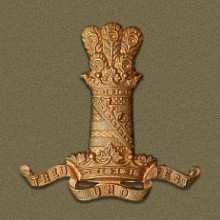
The 11th Hussars (Prince Albert's Own) was a cavalry regiment of the British Army established in 1715. It saw service for three centuries including the First World War and Second World War but then amalgamated with the 10th Royal Hussars (Prince of Wales' Own) to form the Royal Hussars in 1969.
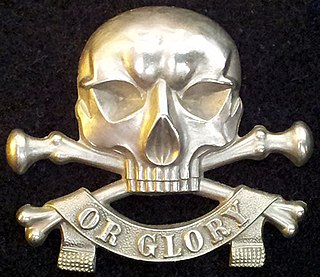
The 17th Lancers (Duke of Cambridge's Own) was a cavalry regiment of the British Army, raised in 1759 and notable for its participation in the Charge of the Light Brigade during the Crimean War. The regiment was amalgamated with the 21st Lancers to form the 17th/21st Lancers in 1922.

The 5th Royal Irish Lancers was a cavalry regiment of the British Army. It saw service for three centuries, including the First World War. It amalgamated with the 16th The Queen's Lancers to become the 16th/5th Lancers in 1922.

The 9th Queen's Royal Lancers was a cavalry regiment of the British Army, first raised in 1715. It saw service for three centuries, including the First and Second World Wars. The regiment survived the immediate post-war reduction in forces, but was amalgamated with the 12th Royal Lancers to form the 9th/12th Royal Lancers in 1960.

The 13th Hussars was a cavalry regiment of the British Army established in 1715. It saw service for three centuries including the Napoleonic Wars, the Crimean War and the First World War but then amalgamated with the 18th Royal Hussars, to form the 13th/18th Royal Hussars in 1922.

The 20th Hussars was a cavalry regiment of the British Army. After service in the First World War it was amalgamated with the 14th King's Hussars to form the 14th/20th King's Hussars in 1922.

The 14th King's Hussars was a cavalry regiment in the British Army, first raised in 1715. It saw service for two centuries, including the First World War, before being amalgamated with the 20th Hussars to form the 14th/20th King's Hussars in 1922.

The 18th Royal Hussars (Queen Mary's Own) was a cavalry regiment of the British Army, first formed in 1759. It saw service for two centuries, including the First World War before being amalgamated with the 13th Hussars to form the 13th/18th Royal Hussars in 1922.
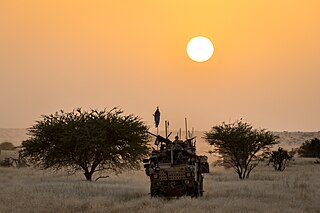
There are 13 cavalry Regiments of the British Army each with its own unique cap badge, regimental traditions, and history. Of the currently nine regular cavalry regiments, two serve as armoured regiments, three as armoured cavalry regiments, three as light cavalry, and one as a mounted ceremonial regiment. There are also four yeomanry regiments of the Army Reserve, of these, three serve as light cavalry and one as an armoured regiment. Each yeomanry light cavalry unit has been paired with a regular unit of the same role, the armoured yeomanry unit is paired with the two regular armoured units. All except the Household Cavalry are part of the British Army's Royal Armoured Corps.

The 12th Royal Lancers was a cavalry regiment of the British Army first formed in 1715. It saw service for three centuries, including the First World War and the Second World War. The regiment survived the immediate post-war reduction in forces, but was slated for reduction in the 1957 Defence White Paper, and was amalgamated with the 9th Queen's Royal Lancers to form the 9th/12th Royal Lancers in 1960.

The 2nd Dragoon Guards (Queen's Bays) was a cavalry regiment of the British Army. It was first raised in 1685 by the Earl of Peterborough as the Earl of Peterborough's Regiment of Horse by merging four existing troops of horse.

The 15th The King's Hussars was a cavalry regiment in the British Army. First raised in 1759, it saw service over two centuries, including the First World War, before being amalgamated with the 19th Royal Hussars into the 15th/19th The King's Royal Hussars in 1922.

The 7th Queen's Own Hussars was a cavalry regiment in the British Army, first formed in 1689. It saw service for three centuries, including the First World War and the Second World War. The regiment survived the immediate post-war reduction in forces, but following the 1957 Defence White Paper, it was amalgamated with the 3rd The King's Own Hussars, forming the Queen's Own Hussars in 1958.

The British Army during the Napoleonic Wars experienced a time of rapid change. At the beginning of the French Revolutionary Wars in 1793, the army was a small, awkwardly administered force of barely 40,000 men. By the end of the period, the numbers had vastly increased. At its peak, in 1813, the regular army contained over 250,000 men. The British infantry was "the only military force not to suffer a major reverse at the hands of Napoleonic France."
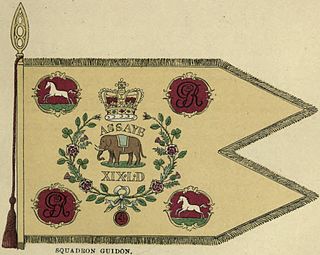
The 19th Light Dragoons was a cavalry regiment of the British Army created in 1781 for service in British India. The regiment served in India until 1806, and in North America during the War of 1812, and was disbanded in Britain in 1821.

Antoine Maurin commanded a French cavalry division in 1814 during the Napoleonic Wars and in 1815 led his troops against the Prussians at Ligny where he was wounded. His army service began in 1792 during the French Revolution when he enlisted in a cavalry regiment as a trooper. He spent his entire military career as a cavalryman. During the French Revolutionary Wars he advanced through the ranks and became commander of a light cavalry regiment in 1802. While only a colonel, he commanded a brigade at Caldiero in October 1805. He fought in the Friedland campaign in 1807 and attained the rank of general officer that year. As a cavalry brigadier, he participated in the 1807 Invasion of Portugal but was captured in 1808 and held until 1812. He led a brigade in 1813 and a division in 1814 during the War of the Sixth Coalition. After fighting for Napoleon during the Hundred Days, he retired in 1823. His surname is one of the names inscribed under the Arc de Triomphe, on Column 40.

Pierre Margaron led the French cavalry at the Battle of Vimeiro in 1808. He joined a volunteer battalion in 1792. He rose in rank during the French Revolutionary Wars until he commanded a heavy cavalry regiment in 1798. He led his horsemen at the Trebbia, Novi and Genola in 1799 and Pozzolo and San Massimo in 1800. He became a general of brigade in 1803 and led a corps light cavalry brigade at Austerlitz, Jena and Lübeck. He participated in the 1807 invasion of Portugal and fought at Évora and Vimeiro. From 1810 to 1812 he held a post in the interior. He became a general of division in 1813 and led troops at the Battle of Leipzig. His surname is one of the names inscribed under the Arc de Triomphe, on Column 2.
Four cavalry regiments of the British Army have been called the 20th Regiment of Light Dragoons:
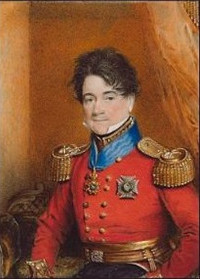
General Sir Thomas Hawker KCH was a British Army cavalry officer. Hawker began his career in the 11th Light Dragoons in 1795 and fought with them during the 1799 Anglo-Russian invasion of Holland. In 1804, he purchased the rank of major with the 20th Light Dragoons and served with them in Spain during the Peninsular War. He was promoted to command of the regiment in 1808. Hawker served in the force sent to occupy the Republic of Genoa in 1814 and shortly after was promoted to colonel and given command of a light cavalry brigade. Spending some time on half pay after the end of the Napoleonic Wars he returned to active service as lieutenant-colonel of the 13th Light Dragoons. Hawker was in the East Indies between 1822--26 and 1830-36 and was promoted to major-general in 1825. He was appointed a Knight Commander of the Royal Guelphic Order in 1837 and colonel of the 6th Regiment of Dragoon Guards in 1839. Hawker was promoted to the brevet rank of general in 1854.
20th Dragoons Alexandria Expedition 1807.